skip to main |
skip to sidebar
I'm sure that there are dozens of recipes for green rice Indian-style on the blogosphere, and dozens more if you were to look for "spinach rice" or "spinach pulao" or "spinach masala rice" or for any such combination that you care to come up with... but, like Frank Sinatra (much) before me, I didn't do it in any of those other dozens of ways - instead, I did it "Myyyyyy Waaaaaaayyy". Just be glad that I cooked it Myyyyyy Waaaaaaayyy, instead of singing it - I don't think that my singing would be particularly appreciated, whereas chances of my recipe being appreciated are quite good... or so I like to think. But, more importantly - what do YOU think?
Recipe for: Spinach black-sesame masala rice
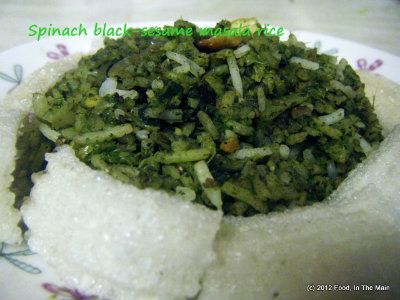
Ingredients:
4-5 cups basmati rice, pre-cooked al dente
1 cup shredded green cabbage (I used savoy)
1 large onion, sliced thinly
2 tbsp chopped mint
1 tbsp oil
1/2 tsp cumin seeds, crushed or left whole
1 tsp ghee
10-15 cashewnuts, broken, for garnish
a pinch of soda bicarb
Salt to taste
For the wet masala
1 cup chopped spinach, loosely packed
1 cup chopped coriander leaves, loosely packed
4-5 green chillies (or as per taste)
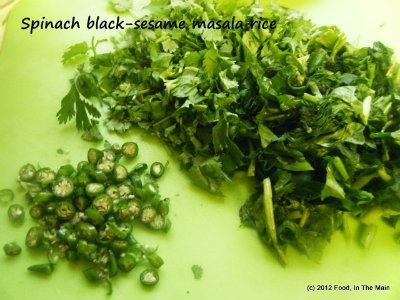
1" piece ginger
For the dry masala
1 tbsp coriander seeds
1 tbsp black sesame seeds
1 tbsp tur dal
2-3 dry red chillies (optional)
Method:
1. Grind all the ingredients for the wet masala to a smooth paste and set aside till required.
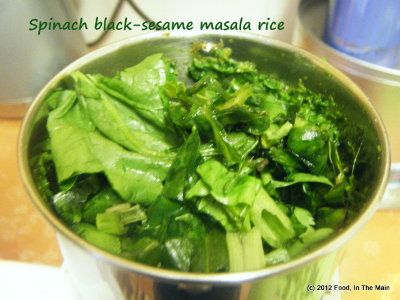
Do not add any extra water while grinding.
2. Dry-roast the dry masala ingredients in a small pan over medium heat,

stirring frequently, till they are aromatic and the dal is golden brown. Do not let them burn. When cool, grind them to a powder (doesn't have to be very smooth) and reserve.
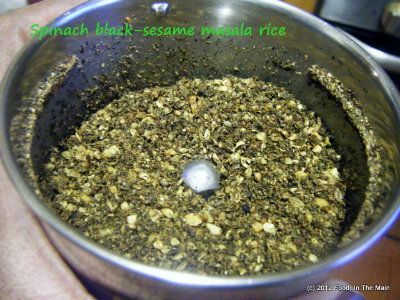
3. Heat the ghee in a big kadai or wok and fry the cashew nuts till they are a pale golden brown. Remove from the pan and set aside till required.
4. In the same pan, heat the 1 tbsp oil. Add 1/2 tsp cumin seeds and let them sizzle for 10 seconds, then add the sliced onion.
5. Fry 2-3 till they begin to soften, then add the cabbage.

Stir well, then cover the pan tightly and let the cabbage cook till nearly done, about 7 minutes.
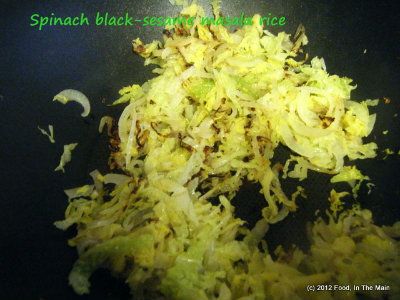
6. Now add the ground spinach masala with a pinch of soda bicarb and fry it for about 5-6 minutes, stirring,
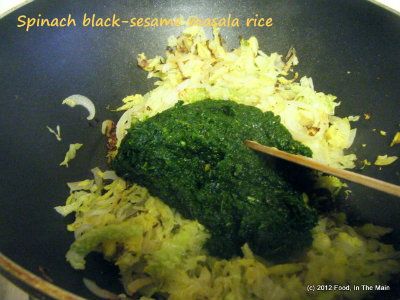
until it loses most of the excess moisture and doesn't smell raw any more.

7. Add the cooked rice now, along with salt to taste,
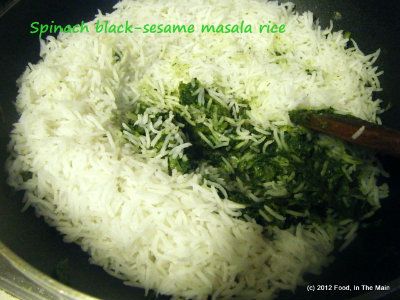
and mix it in carefully with the masala, without mushing up the grains,
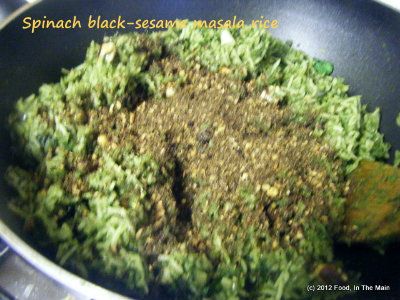
then stir in the dry masala powder.
8. Sprinkle the chopped mint and fried cashewnuts over the rice,
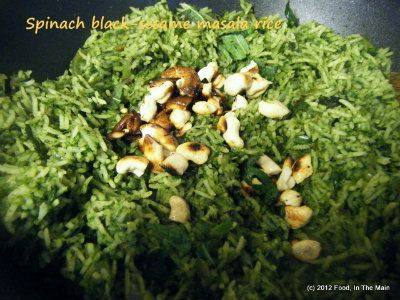
and serve hot along with fried papad/appalam or potato crisps, and onion raita.
RECIPE: SPINACH BLACK-SESAME MASALA RICE
Ingredients:
4-5 cups basmati rice, pre-cooked al dente
1 cup shredded green cabbage (I used savoy)
1 large onion, sliced thinly
2 tbsp chopped mint
1 tbsp oil
1/2 tsp cumin seeds, crushed or left whole
1 tsp ghee
10-15 cashewnuts, broken, for garnish
a pinch of soda bicarb
Salt to taste
For the wet masala
1 cup chopped spinach, loosely packed
1 cup chopped coriander leaves, loosely packed
4-5 green chillies (or as per taste)
1" piece ginger
For the dry masala
1 tbsp coriander seeds
1 tbsp black sesame seeds
1 tbsp tur dal
2-3 dry red chillies (optional)
Method
1. Grind all the ingredients for the wet masala to a smooth paste and set aside till required. Do not add any extra water while grinding.
2. Dry-roast the dry masala ingredients in a small pan over medium heat, stirring frequently, till they are aromatic and the dal is golden brown. Do not let them burn. When cool, grind them to a
powder (doesn't have to be very smooth) and reserve.
3. Heat the ghee in a big kadai or wok and fry the cashew nuts till they are a pale golden brown. Remove from the pan and set aside till required.
4. In the same pan, heat the 1 tbsp oil. Add 1/2 tsp cumin seeds and let them sizzle for 10 seconds, then add the sliced onion.
5. Fry 2-3 till they begin to soften, then add the cabbage. Stir well, then cover the pan tightly and let the cabbage cook till nearly done, about 7 minutes.
6. Now add the ground spinach masala with a pinch of soda bicarb and fry it for about 5-6 minutes, stirring, until it loses most of the excess moisture and doesn't smell raw any more.
7. Add the cooked rice now, along with salt to taste, and mix it in carefully with the masala without mushing up the grains, then stir in the dry masala powder.
8. Sprinkle the chopped mint and fried cashewnuts over the rice, and serve hot along with fried papad/appalam or potato crisps, and onion raita.
Serendipity isn't something that manifests itself often in my life, so the rare occasions that it does, it's very exciting. On the day after I made the baked cabbage-onion masala vadas, I saw a recipe for vada-kari (literal meaning "curry made from vadas") on Srivalli's blog. There I was, with day-old vadas to hand, and there it was, a recipe to use them - like I said, exciting!
I think this particular curry must originaly have come about as a way of using up stale, hard vadas that would not otherwise be edible to most people - the fact that I like to nibble on them is by the way. I'm not most people. Nor are, I suspect, most people me. (It works both ways, as you can see. Hehe.)
Anyway, I changed very little from the original recipe, except perhaps the quantities. Oh, and I omitted the fried gram because I didn't have any, and reduced the quantity of coconut. It was one heck of a tasty curry, and the plump vadas, juicy from soaking up the liquid from the gravy, were delicious. I had them over rice with a simple cabbage-peas dry curry. Yum-my. Thank you, Srivalli's mother, for providing the recipe for vada-kari.
Man, do I love ever my fellow-food bloggers and their wide variety of homespun recipes! Long live the Internet, I say.
Recipe for: Vada-kari (lentil fritters in tomato-coconut gravy)
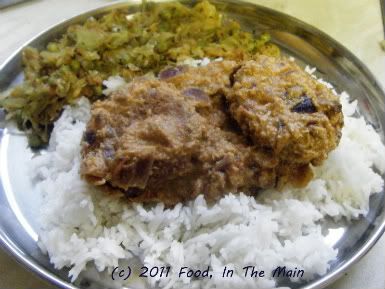 Ingredients:
About 8 day-old paruppu vadas (baked or fried)
1 medium tomato, chopped
1 medium onion, chopped fine
1 tsp ginger-garlic, grated
Ingredients:
About 8 day-old paruppu vadas (baked or fried)
1 medium tomato, chopped
1 medium onion, chopped fine
1 tsp ginger-garlic, grated
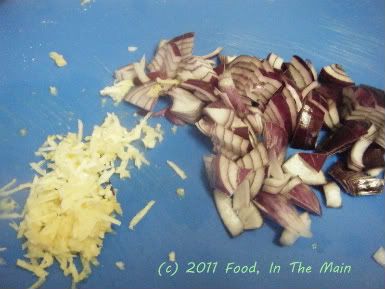 3 tsp oil
Salt to taste
Coriander leaves for garnish
For the ground masala:
3 tsp oil
Salt to taste
Coriander leaves for garnish
For the ground masala:
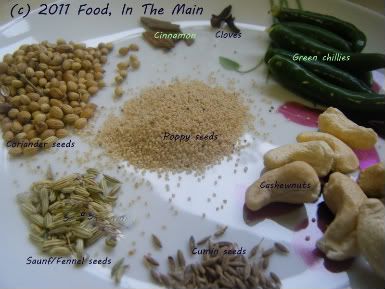 1/2 tsp fennel/saunf
1 tsp coriander seeds
1 tsp poppy seeds
1/4 tsp cumin seeds
1/2" piece cinnamon stick
2 cloves
3-5 fresh green chillies
5 cashewnuts
5-6 coconut pieces, each about 2cm long (or 2 tbsp grated coconut)
Method:
1. Heat one tsp of oil and fry all the ingredients for the ground masala till aromatic.
1/2 tsp fennel/saunf
1 tsp coriander seeds
1 tsp poppy seeds
1/4 tsp cumin seeds
1/2" piece cinnamon stick
2 cloves
3-5 fresh green chillies
5 cashewnuts
5-6 coconut pieces, each about 2cm long (or 2 tbsp grated coconut)
Method:
1. Heat one tsp of oil and fry all the ingredients for the ground masala till aromatic.
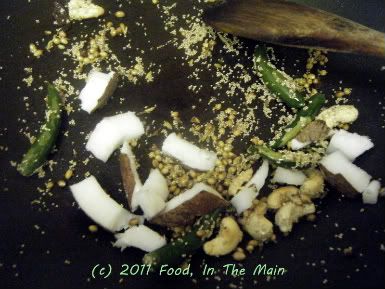 Add the coconut pieces/grated coconut and stir-fry for another two minutes, then remove to a plate and set aside to cool.
2. Heat the other tsp of oil and fry the tomatoes till they are mushy. Set aside to cool.
Add the coconut pieces/grated coconut and stir-fry for another two minutes, then remove to a plate and set aside to cool.
2. Heat the other tsp of oil and fry the tomatoes till they are mushy. Set aside to cool.
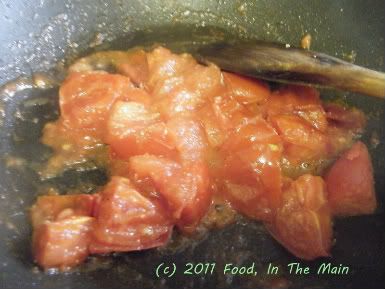 3. Once they are all cool, grind the fried ingredients and the tomatoes to a smooth paste using a little warm water if necessary. Reserve.
3. Once they are all cool, grind the fried ingredients and the tomatoes to a smooth paste using a little warm water if necessary. Reserve.
 4. Now heat the remaining oil and add the ginger-garlic paste, stirring for 30 seconds or so.
5. Then add the onions and fry till they become soft and turn pale brown.
4. Now heat the remaining oil and add the ginger-garlic paste, stirring for 30 seconds or so.
5. Then add the onions and fry till they become soft and turn pale brown.
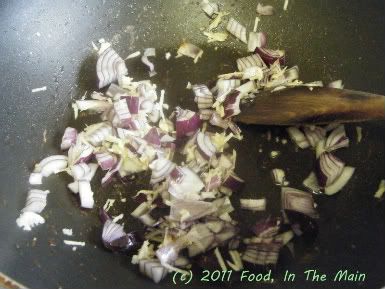 6. Next, add the ground masala paste and stir it in,
6. Next, add the ground masala paste and stir it in,
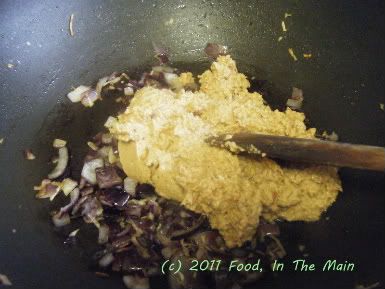 adding a cupful of water.
adding a cupful of water.
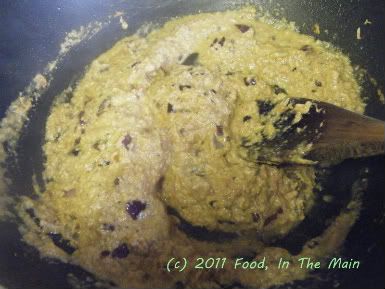 You can add a little more water at this stage, depending on how many vadas you have.
You can add a little more water at this stage, depending on how many vadas you have.
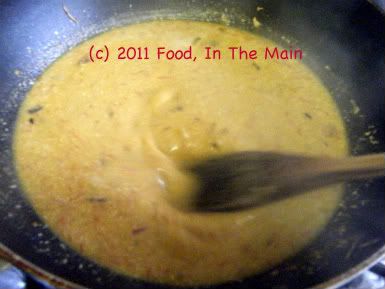 5. Bring to a gentle boil over medium heat and simmer the gravy for 5 minutes or so, till it comes together and starts to thicken.
6. Drop the vadas into the gravy now and simmer the curry for 2-3 minutes, spooning the gravy over the vadas occasionally, if necessary.
5. Bring to a gentle boil over medium heat and simmer the gravy for 5 minutes or so, till it comes together and starts to thicken.
6. Drop the vadas into the gravy now and simmer the curry for 2-3 minutes, spooning the gravy over the vadas occasionally, if necessary.
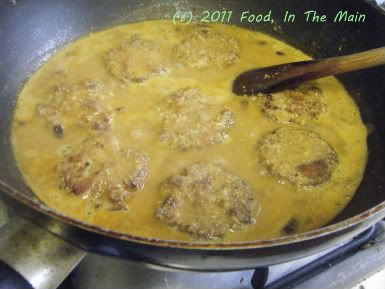 Garnish with coriander leaves and serve hot with idlis or dosas, or over rice if you like. Add a dry vegetable curry for a complete meal.
Note: If the curry sits for a while, the vadas will absorb the moisture and make the curry very thick.
RECIPE: VADA-KARI (LENTIL FRITTERS IN TOMATO-COCONUT GRAVY)
Ingredients:
About 8 day-old paruppu vadas (baked or fried)
1 medium tomato, chopped
1 medium onion, chopped fine
1 tsp ginger-garlic paste
3 tsp oil
Salt to taste
Coriander leaves for garnish
For the ground masala:
1/2 tsp fennel/saunf
1 tsp coriander seeds
1 tsp poppy seeds
1/4 tsp cumin seeds
1/2" piece cinnamon stick
2 cloves
3-5 fresh green chillies
5 cashewnuts
5-6 coconut pieces, each about 2cm long (or 2 tbsp grated coconut)
Method:
1. Heat one tsp of oil and fry all the ingredients for the ground masala till aromatic. Add the coconut pieces/grated coconut and stir-fry for another two minutes, then remove to a plate and set aside to cool.
2. Heat the other tsp of oil and fry the tomatoes till they are mushy. Set aside to cool.
3. Once they are all cool, grind the fried ingredients and the tomatoes to a smooth paste using a little warm water if necessary. Reserve.
4. Now heat the remaining oil and add the ginger-garlic paste, stirring for 30 seconds or so.
5. Then add the onions and fry till they become soft and turn pale brown.
6. Next, add the ground masala paste and stir it in, adding a cupful of water. You can add a little more water at this stage, depending on how many vadas you have.
5. Bring to a gentle boil over medium heat and simmer the gravy for 5 minutes or so, till it comes together and starts to thicken.
6. Drop the vadas into the gravy now and simmer the curry for 2-3 minutes, spooning the gravy over the vadas occasionally, if necessary.
Garnish with coriander leaves and serve hot with idlis or dosas, or over rice if you like. Add a dry vegetable curry for a complete meal.
Note: If the curry sits for a while, the vadas will absorb the moisture and make the curry very thick.
Garnish with coriander leaves and serve hot with idlis or dosas, or over rice if you like. Add a dry vegetable curry for a complete meal.
Note: If the curry sits for a while, the vadas will absorb the moisture and make the curry very thick.
RECIPE: VADA-KARI (LENTIL FRITTERS IN TOMATO-COCONUT GRAVY)
Ingredients:
About 8 day-old paruppu vadas (baked or fried)
1 medium tomato, chopped
1 medium onion, chopped fine
1 tsp ginger-garlic paste
3 tsp oil
Salt to taste
Coriander leaves for garnish
For the ground masala:
1/2 tsp fennel/saunf
1 tsp coriander seeds
1 tsp poppy seeds
1/4 tsp cumin seeds
1/2" piece cinnamon stick
2 cloves
3-5 fresh green chillies
5 cashewnuts
5-6 coconut pieces, each about 2cm long (or 2 tbsp grated coconut)
Method:
1. Heat one tsp of oil and fry all the ingredients for the ground masala till aromatic. Add the coconut pieces/grated coconut and stir-fry for another two minutes, then remove to a plate and set aside to cool.
2. Heat the other tsp of oil and fry the tomatoes till they are mushy. Set aside to cool.
3. Once they are all cool, grind the fried ingredients and the tomatoes to a smooth paste using a little warm water if necessary. Reserve.
4. Now heat the remaining oil and add the ginger-garlic paste, stirring for 30 seconds or so.
5. Then add the onions and fry till they become soft and turn pale brown.
6. Next, add the ground masala paste and stir it in, adding a cupful of water. You can add a little more water at this stage, depending on how many vadas you have.
5. Bring to a gentle boil over medium heat and simmer the gravy for 5 minutes or so, till it comes together and starts to thicken.
6. Drop the vadas into the gravy now and simmer the curry for 2-3 minutes, spooning the gravy over the vadas occasionally, if necessary.
Garnish with coriander leaves and serve hot with idlis or dosas, or over rice if you like. Add a dry vegetable curry for a complete meal.
Note: If the curry sits for a while, the vadas will absorb the moisture and make the curry very thick.
While vegetarian food is not hard to find in most pubs, hotels etc, the choice is woefully limited – usually pasta of some kind, vegetarian chili, bean burger, sometimes a vegetable curry or Mediterranean-veg lasagna chock full of gross aubergines/eggplant and zucchini (because, you know, they’re Mediterranean vegetables and apparently no other veggies are known to ever be used in Mediterranean cuisine). Some places offer two vegetarian options, if you’re lucky. But usually it’s just one of the above, and vegetarians have to like it or lump it.
I should be glad that there’s at least SOMETHING non-meaty and non-fishy to eat in Western restaurants, and I suppose I am... but I still can’t help wishing that their chefs would show just a little imagination for vegetarians. Which is why I like a little pub in Wem (Pete’s hometown), called the Old Post Office (Pete’s home-away-from), which is owned and run by Pete’s business partner Guy, and a couple of his friends. The pub is called the Old Post Office because before it was converted to a pub, it used to be the old post office premises before they moved lock stock and barrel to the new post office premises – well, why did you think the pub’s name is what it is?
Anyway, I like the pub for all sorts of reasons – one, the younger crowd (the noisy, binge drinking, annoying kind) stay away because it doesn’t offer them much in the way of a “hep” ambience. Two, the pub plays good music on an excellent sound system (which Pete set up). Three, the décor is homely (I especially love the squashy-soft sofas from whose hug it’s difficult to get out) but with an exotic touch in the way of beautiful sculptures and paintings and wall-hangings which Guy brought back from his trips to Africa. The effect is casual and comfortable.
And now for the fourth and most important reason - the food. The pub offers a carvery every Sunday, with at least two different choices of meat, which Pete loves. The Sunday carvery has had very good reviews in the local newspapers, because the servings and accompaniments are generous – and all freshly cooked that day, nothing from frozen. I would be happy to eat just the accompaniments that are available – roast potatoes, boiled potatoes, cabbage, peas, cauliflower or broccoli cheese, roast parsnips, carrots, leeks, stuffing balls, Yorkshire puddings - a veritable feast!
But I get a special entree just for me as the only vegetarian who goes there for Sunday lunch. The two lady chefs make it a point to try out a new recipe for me, even though – or perhaps especially because – vegetarian food is not their comfort zone. It’s not even as if I’m a guinea pig… apparently they try out their new recipes during the week on the regulars (the pub makes it a point to provide sandwiches and other finger food on the house, in the evening), asking them for feedback. And then, on a Sunday, the recipe makes its formal debut – just for me (or any other vegetarian, assuming any comes along. It hasn’t happened yet, they say.)
Since I know that there won’t be any aubergine in anything (the staff all know of my loathing for this gross slimy-when-cooked vegetable), I’m always delighted to try whatever they've made – and so far, every single thing has been a hit. It's really nice of them to take the trouble to make anything, just for one person, especially when they've got their hands full catering for all the regular guests.
One time it was peppers stuffed with a really nice rice mixture, and since I had peppers at home last Sunday (when Pete and Bex were having a Sunday lunch at home), I decided to make my own main course and share the accompaniments (called “trimmings”) with my husband and stepdaughter for our family meal. Pete served everything in a giant Yorkshire pudding - yummy!
Recipe for: Stuffed green peppers with nutty rice
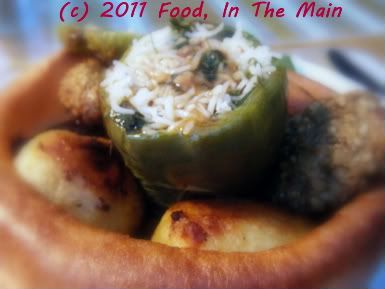
Ingredients:
2 green peppers (capsicum/bell pepper)
1/4 cup paneer, diced into 1/2 cm cubes

1 cup cooked basmati rice
1 green chilli, sliced into thin rings
4 tbsp shredded methi leaves (optional)
1/2 cup shredded coriander leaves
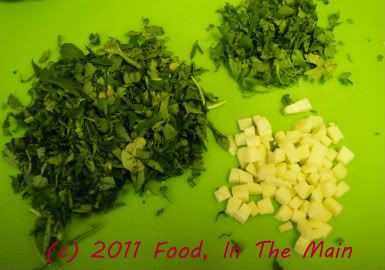
1/2 tsp cumin powder
2 tbsp mixed nuts (peanuts, cashewnuts, pecans), chopped
2 tsp raisins or sultanas
1/2 tsp freshly ground black pepper
1/4 tsp garam masala
2 tsp oil
Salt to taste
Method:
1. Slice off the tops of the peppers and carefully remove the seeds and pith. Make sure the peppers can remain upright; even up the bottoms if required so that they sit flat. Reserve the tops, don't throw them away.
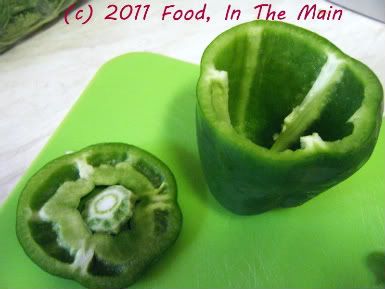
2. Heat the oil in a pan and add the chillies, paneer and chopped nuts. Stir fry till the nuts and the paneer are pale golden brown.
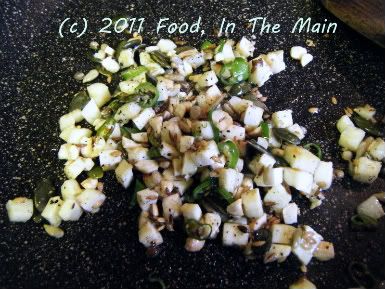
3. Add the coriander and methi leaves and fry till they wilt.
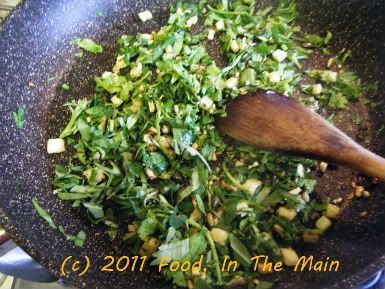
4. Add the sultanas/raisins.
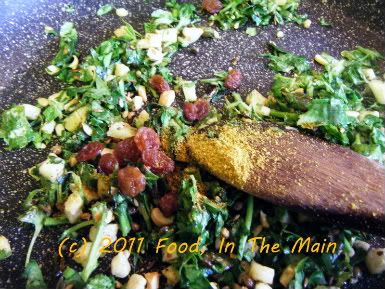
5. Now mix in the rice, garam masala, black pepper powder and salt to taste. Heat this stuffing thoroughly, then turn the heat off and let it cool.
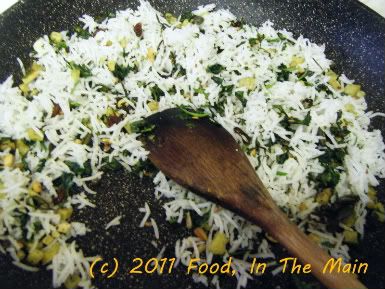
6. Spoon the filling into the prepared peppers, pressing down with the back of the spoon to get as much of the stuffing in as possible,
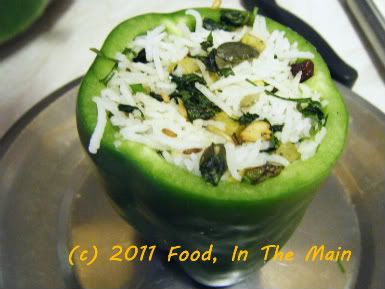
then put the tops of the peppers back on.
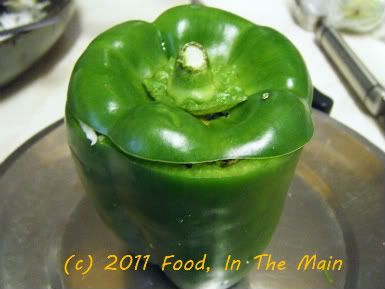
7. Place the stuffed peppers on a baking tray and spray them with Pam on the outside, or brush them with a little oil. Bake in the oven at 200C for 15 minutes or so, or till the peppers are a soft and wrinkled. Don't overcook them.
8. Serve the peppers hot as a main course with a selection of vegetables, and vegetarian gravy.
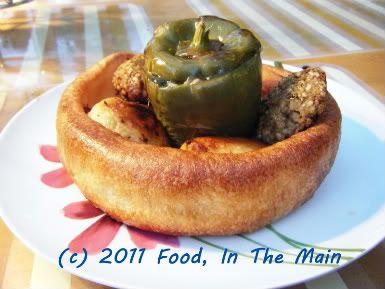
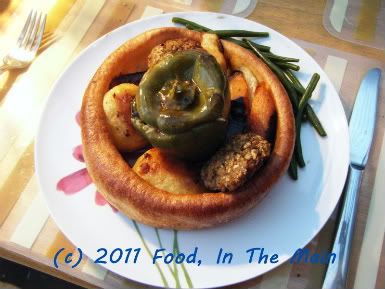
RECIPE: STUFFED GREEN PEPPERS WITH NUTTY RICE
Ingredients:
2 green peppers (capsicum/bell pepper)
1/4 cup paneer, diced into 1/2 cm cubes
1 cup cooked basmati rice
1 green chilli, sliced into thin rings
4 tbsp shredded methi leaves (optional)
1/2 cup shredded coriander leaves
1/2 tsp cumin powder
2 tbsp mixed nuts (peanuts, cashewnuts, pecans), chopped
2 tsp raisins or sultanas
1/2 tsp freshly ground black pepper
1/4 tsp garam masala
2 tsp oil
Salt to taste
Method:
1. Slice off the tops of the peppers and carefully remove the seeds and pith. Make sure the peppers can remain upright; even up the bottoms if required so that they sit flat. Reserve the tops, don't throw them away.
2. Heat the oil in a pan and add the chillies, paneer and chopped nuts. Stir fry till the nuts and the paneer are pale golden brown.
3. Add the coriander and methi leaves and fry till they wilt.
4. Add the sultanas/raisins.
5. Now mix in the rice, garam masala, black pepper powder and salt to taste. Heat this stuffing thoroughly, then turn the heat off and let it cool.
6. Spoon the filling into the prepared peppers, pressing down with the back of the spoon to get as much of the stuffing in as possible, then put the tops of the peppers back on.
7. Place the stuffed peppers on a baking tray and spray them with Pam on the outside, or brush them with a little oil. Bake in the oven at 200C for 15 minutes or so, or till the peppers are a soft and wrinkled. Don't overcook them.
8. Serve the peppers hot as a main course with a selection of vegetables, and vegetarian gravy.
The most common South Indian item made with rava or semolina is upma. Upma is not my first choice of breakfast or tiffin items, as I might have mentioned before. I don’t hate it, it’s just not my first choice. If I do have it at home, I like it plain, without anything added to jazz it up - like onions or tomatoes or ginger or any other vegetables – but with sugar sprinkled on top, or on the side – I’m not fussy (oh, the irony).
But when it comes to rava kesari, I have no objections at all. A friend who knows of my tepid feelings towards upma once commented that rava kesari is just sweet upma. I’m not certain now, but I think she might have been trying to put me off my serving of kesari – too bad for her it didn’t work. There was no sharing involved from my side, I can tell you.
When I first read about pineapple kesari, a great big light bulb seemed to go off in my head, illuminating every last cobweb in there – now WHY hadn’t the idea of pineapple kesari occurred to me? Adding one of my favourite fruits to a sweet that I liked even “plain” – how perfectly delicious!
And so it was – perfectly delicious.
Note: I have to add that my kesari was a bit on the dry side (ok by me) because I skimped on the ghee – well, slightly skimped. If you, on the other hand, weigh in on the skimpy side of the scales, by all means add another generous tablespoon of the good stuff. Your pineapple kesari will not suffer for it, I assure you.
Recipe for: Pineapple rava (cream of wheat) kesari
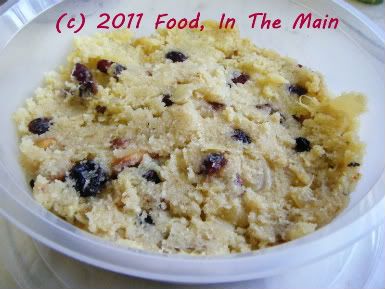 Ingredients:
Ingredients:
1/2 cup rava (semolina)
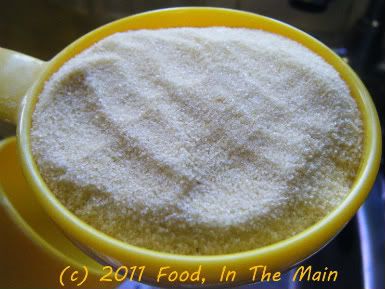 1/4 tsp saffron strands
4 tbsp warm milk
1/2 cup hot milk
1/4 cup crushed/chopped pineapple (fresh or canned)
1/4 tsp saffron strands
4 tbsp warm milk
1/2 cup hot milk
1/4 cup crushed/chopped pineapple (fresh or canned)
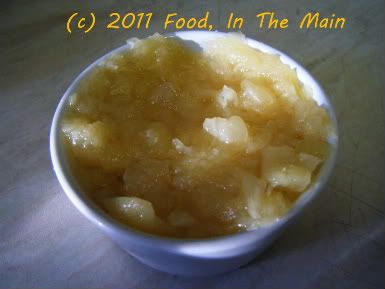 1 cup water
1/4 cup sugar (or to taste)
1/8 tsp cardamom powder
4-5 cashews, broken in pieces
1 tbsp ghee
2 tbsp raisins or mixed dried berries
1 cup water
1/4 cup sugar (or to taste)
1/8 tsp cardamom powder
4-5 cashews, broken in pieces
1 tbsp ghee
2 tbsp raisins or mixed dried berries
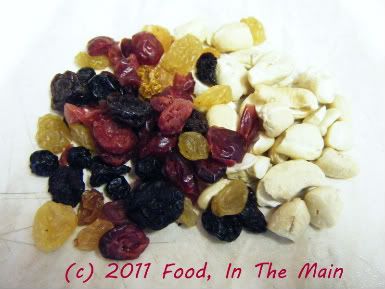
Method:
1. Add saffron to 4 tbsp warm milk and set aside to soak.
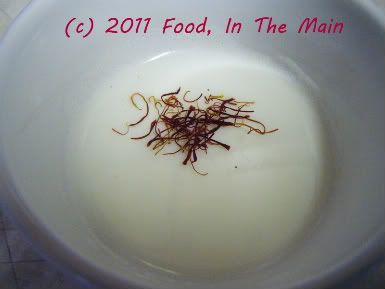 2. Mix the sugar, pineapple and water together and bring to a boil. Lower the heat to a simmer and leave it for 3-4 minutes while you get the rava ready.
2. Mix the sugar, pineapple and water together and bring to a boil. Lower the heat to a simmer and leave it for 3-4 minutes while you get the rava ready.
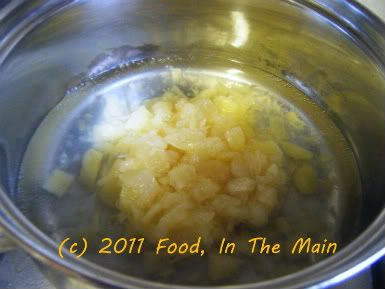 3. Melt the ghee in a small pan and add the cashews and raisins/berries.
3. Melt the ghee in a small pan and add the cashews and raisins/berries.
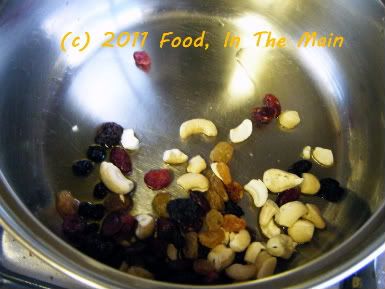 Fry on medium heat till the cashews turn golden brown and the raisins/berries puff up. Remove from pan and reserve.
Fry on medium heat till the cashews turn golden brown and the raisins/berries puff up. Remove from pan and reserve.
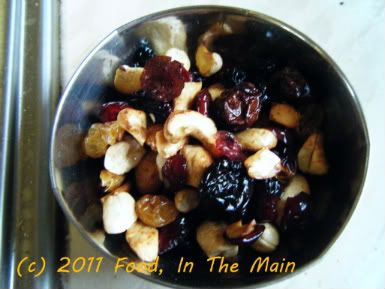 4. Toast the rava (semolina) on low heat in the same pan till it turns a darker shade and becomes aromatic.
4. Toast the rava (semolina) on low heat in the same pan till it turns a darker shade and becomes aromatic.
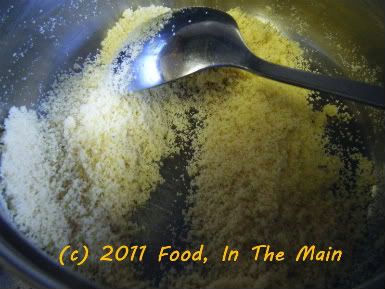 5. Now carefully pour the boiling pineapple mixture over the toasted rava, stirring briskly to avoid lumps forming.
5. Now carefully pour the boiling pineapple mixture over the toasted rava, stirring briskly to avoid lumps forming.
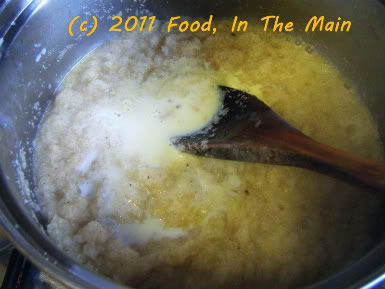 6. Stir in the hot milk as well. Cook the rava for 2-3 minutes longer, then add the ghee-fried cashews and raisins/berries. Serve hot.
6. Stir in the hot milk as well. Cook the rava for 2-3 minutes longer, then add the ghee-fried cashews and raisins/berries. Serve hot.
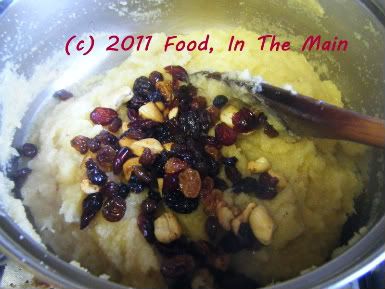
RECIPE: PINEAPPLE RAVA (SEMOLINA) KESARI
Ingredients:
1/2 cup rava (semolina)
1/4 tsp saffron strands
4 tbsp warm milk
1/2 cup hot milk
1/4 cup crushed/chopped pineapple (fresh or canned)
1 cup water
1/4 cup sugar (or to taste)
1/8 tsp cardamom powder
4-5 cashews, broken in pieces
1 tbsp ghee
2 tbsp raisins or mixed dried berries
Method:
1. Add saffron to 4 tbsp warm milk and set aside to soak.
2. Mix the sugar, pineapple and water together and bring to a boil. Lower the heat to a simmer and leave it for 3-4 minutes while you get the rava ready.
3. Melt the ghee in a small pan and add the cashews and raisins/berries. Fry on medium heat till the cashews turn golden brown and the raisins/berries puff up. Remove from pan and reserve.
4. Toast the rava (semolina) on low heat in the same pan till it turns a darker shade and becomes aromatic.
5. Now carefully pour the boiling pineapple mixture over the toasted rava, stirring briskly to avoid lumps forming.
6. Stir in the hot milk as well. Cook the rava for 2-3 minutes longer, then add the ghee-fried cashews and raisins/berries. Serve hot.
This recipe was a sort of off-the-cuff, make-it-up-as-you-go-along creation – and it tasted really nice. It wasn’t so much sweet as it was hot, because I used a Scotch bonnet pepper, and hot is how I like things... but the sweetness was there, all the same.
And that, it would appear, is all I have to say about it. I've been trying to come up with some kind of spin to eke out this post, but I believe I've run out of imagination. I need a ghost-writer with a sense of humour and endless creativity. Any takers?
Recipe for: Hot-sweet vegetable curry
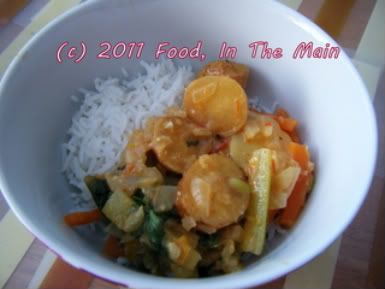 Ingredients:
1/2 cup fingerling or salad potatoes, sliced in 1cm rounds
1/2 cup ripe mango,cubed
1/2 cup tomatoes, chopped
1/4 cup green beans, sliced on the diagonal
1/4 cup carrots, sliced in thin sticks
1/4 cup bottlegourd, sliced in thin sticks
Ingredients:
1/2 cup fingerling or salad potatoes, sliced in 1cm rounds
1/2 cup ripe mango,cubed
1/2 cup tomatoes, chopped
1/4 cup green beans, sliced on the diagonal
1/4 cup carrots, sliced in thin sticks
1/4 cup bottlegourd, sliced in thin sticks
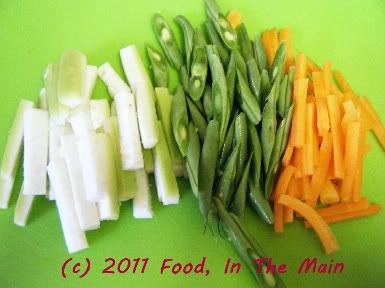 1/2 cup onions, chopped fine
1 cup milk
1/2 tsp cinnamon powder
1 tsp grated ginger
1/2 tsp Kitchen King masala (or your favourite garam masala)
Green chillies to taste
5-6 cashewnuts
2 tbsp oil
A generous handful of chopped coriander leaves for garnish
Method:
1. Toss the sliced potatoes with 1 tbsp oil and roast in the oven at 180C/350F, stirring them after 15 minutes, until they are golden and cooked - about 30 minutes or so. Reserve.
1/2 cup onions, chopped fine
1 cup milk
1/2 tsp cinnamon powder
1 tsp grated ginger
1/2 tsp Kitchen King masala (or your favourite garam masala)
Green chillies to taste
5-6 cashewnuts
2 tbsp oil
A generous handful of chopped coriander leaves for garnish
Method:
1. Toss the sliced potatoes with 1 tbsp oil and roast in the oven at 180C/350F, stirring them after 15 minutes, until they are golden and cooked - about 30 minutes or so. Reserve.
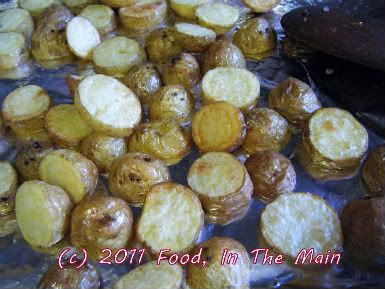 2. Heat 1/2 tbsp oil in a pan and add the ginger and cinnamon powder.
2. Heat 1/2 tbsp oil in a pan and add the ginger and cinnamon powder.
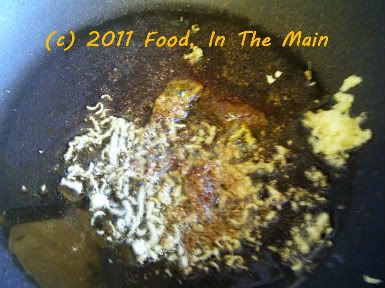 3. Add the chopped tomatoes and cook for 3-4 minutes, or till they start to break up.
3. Add the chopped tomatoes and cook for 3-4 minutes, or till they start to break up.
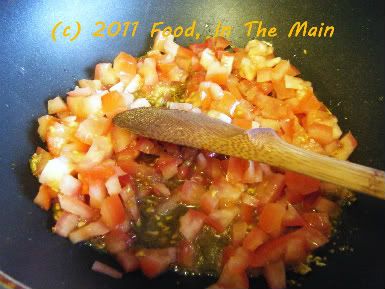 4. Add the chopped mangoes and the chillies, if using. Cook them on medium-high heat, stirring occasionally, until they become soft.
4. Add the chopped mangoes and the chillies, if using. Cook them on medium-high heat, stirring occasionally, until they become soft.
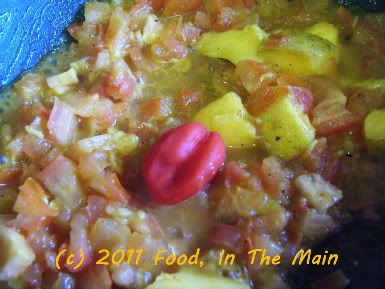 Remove from the heat and let the mixture cool.
Remove from the heat and let the mixture cool.
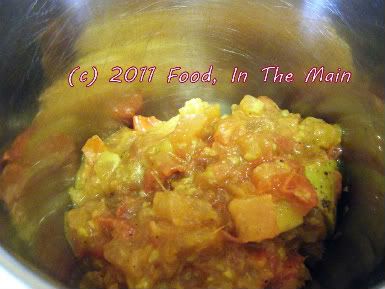 Once it's cool, puree along with the cashewnuts and reserve.
5. Now heat the remaining 1/2 tbsp oil and fry the chopped onions.
Once it's cool, puree along with the cashewnuts and reserve.
5. Now heat the remaining 1/2 tbsp oil and fry the chopped onions.
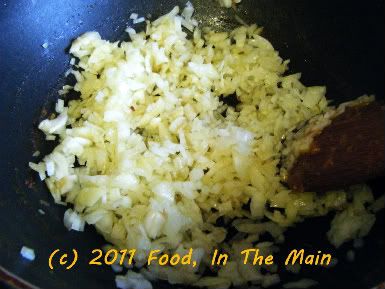 6. When the onions are soft and pale brown, add the sliced carrots, beans and bottlegourd.
6. When the onions are soft and pale brown, add the sliced carrots, beans and bottlegourd.
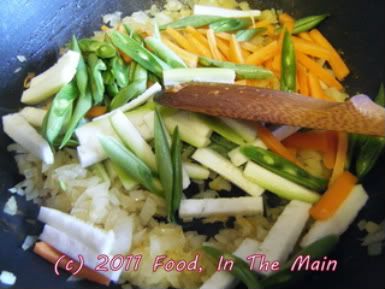 Add one cup water, cover the pan and let the vegetables cook till just done.
7. Stir in one cup milk and bring the mixture to a gentle boil on medium heat.
Add one cup water, cover the pan and let the vegetables cook till just done.
7. Stir in one cup milk and bring the mixture to a gentle boil on medium heat.
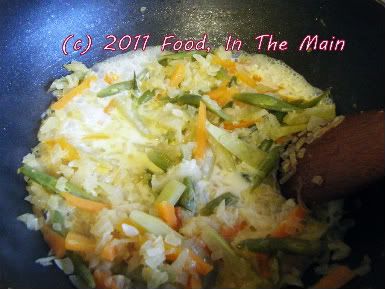 8. Add the pureed tomato-mango mixture and mix it in along with the Kitchen King masala powder..
8. Add the pureed tomato-mango mixture and mix it in along with the Kitchen King masala powder..
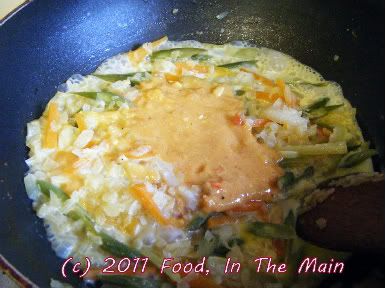 9. Bring to a gentle boil, then add the oven-fried potatoes and stir them in.
9. Bring to a gentle boil, then add the oven-fried potatoes and stir them in.
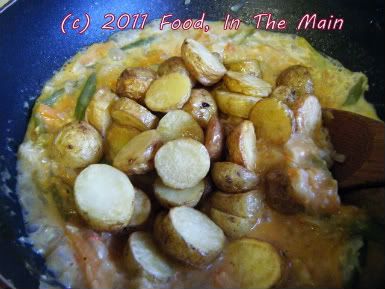 10. Let the curry simmer for 6-7 minutes on medium heat. I like the gravy to be fairly thick, but if you prefer it more runny, add water or milk as required and simmer for a few minutes longer. Add salt to taste. Then garnish with chopped coriander leaves and serve hot with steamed rice.
10. Let the curry simmer for 6-7 minutes on medium heat. I like the gravy to be fairly thick, but if you prefer it more runny, add water or milk as required and simmer for a few minutes longer. Add salt to taste. Then garnish with chopped coriander leaves and serve hot with steamed rice.
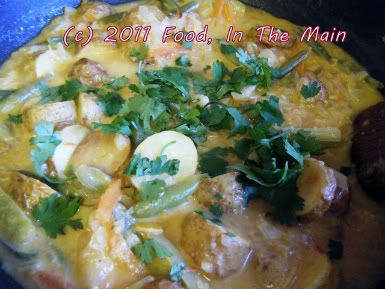 RECIPE: HOT-SWEET VEGETABLE CURRY
Ingredients:
1/2 cup fingerling or salad potatoes, sliced in 1cm rounds
1/2 cup ripe mango,cubed
1/2 cup tomatoes, chopped
1/4 cup green beans, sliced on the diagonal
1/4 cup carrots, sliced in thin sticks
1/4 cup bottlegourd, sliced in thin sticks
1/2 cup onions, chopped fine
1 cup milk
1/2 tsp cinnamon powder
1 tsp grated ginger
1/2 tsp Kitchen King masala (or your favourite garam masala)
Green chillies to taste
5-6 cashewnuts
2 tbsp oil
A generous handful of chopped coriander leaves for garnish
Method:
1. Toss the sliced potatoes with 1 tbsp oil and roast in the oven at 180C/350F, stirring them after 15 minutes, until they are golden and cooked - about 30 minutes or so. Reserve.
2. Heat 1/2 tbsp oil in a pan and add the ginger and cinnamon powder.
3. Add the chopped tomatoes and cook for 3-4 minutes, or till they start to break up.
4. Add the chopped mangoes and the chillies, if using. Cook them on medium-high heat, stirring occasionally, until they become soft.
Remove from the heat and let the mixture cool.
Once it's cool, puree along with the cashewnuts and reserve.
5. Now heat the remaining 1/2 tbsp oil and fry the chopped onions.
6. When the onions are soft and pale brown, add the sliced carrots, beans and bottlegourd.
Add one cup water, cover the pan and let the vegetables cook till just done.
7. Stir in one cup milk and bring the mixture to a gentle boil on medium heat.
8. Add the pureed tomato-mango mixture and mix it in along with the Kitchen King masala powder..
9. Bring to a gentle boil, then add the oven-fried potatoes and stir them in.
10. Let the curry simmer for 6-7 minutes on medium heat. I like the gravy to be fairly thick, but if you prefer it more runny, add water or milk as required and simmer for a few minutes longer.Add salt to taste. Then garnish with chopped coriander leaves and serve hot with steamed rice.
RECIPE: HOT-SWEET VEGETABLE CURRY
Ingredients:
1/2 cup fingerling or salad potatoes, sliced in 1cm rounds
1/2 cup ripe mango,cubed
1/2 cup tomatoes, chopped
1/4 cup green beans, sliced on the diagonal
1/4 cup carrots, sliced in thin sticks
1/4 cup bottlegourd, sliced in thin sticks
1/2 cup onions, chopped fine
1 cup milk
1/2 tsp cinnamon powder
1 tsp grated ginger
1/2 tsp Kitchen King masala (or your favourite garam masala)
Green chillies to taste
5-6 cashewnuts
2 tbsp oil
A generous handful of chopped coriander leaves for garnish
Method:
1. Toss the sliced potatoes with 1 tbsp oil and roast in the oven at 180C/350F, stirring them after 15 minutes, until they are golden and cooked - about 30 minutes or so. Reserve.
2. Heat 1/2 tbsp oil in a pan and add the ginger and cinnamon powder.
3. Add the chopped tomatoes and cook for 3-4 minutes, or till they start to break up.
4. Add the chopped mangoes and the chillies, if using. Cook them on medium-high heat, stirring occasionally, until they become soft.
Remove from the heat and let the mixture cool.
Once it's cool, puree along with the cashewnuts and reserve.
5. Now heat the remaining 1/2 tbsp oil and fry the chopped onions.
6. When the onions are soft and pale brown, add the sliced carrots, beans and bottlegourd.
Add one cup water, cover the pan and let the vegetables cook till just done.
7. Stir in one cup milk and bring the mixture to a gentle boil on medium heat.
8. Add the pureed tomato-mango mixture and mix it in along with the Kitchen King masala powder..
9. Bring to a gentle boil, then add the oven-fried potatoes and stir them in.
10. Let the curry simmer for 6-7 minutes on medium heat. I like the gravy to be fairly thick, but if you prefer it more runny, add water or milk as required and simmer for a few minutes longer.Add salt to taste. Then garnish with chopped coriander leaves and serve hot with steamed rice.




























































